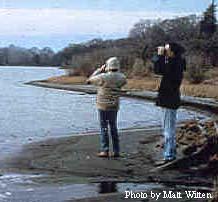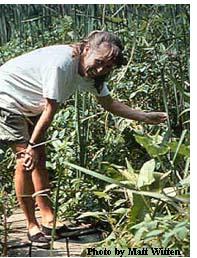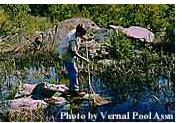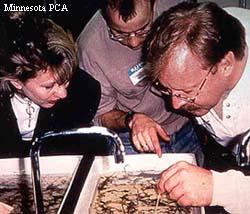Examples of State and Local Wetland Volunteer Monitoring Programs
Arkansas
Arkansas Game and Fish Commission: In the past, the Stream Team program Exit has branched out into wetlands, partly due to droughts (which left wetlands as the only places with water to sample). The Team has put together a wetland monitoring guidance that will be used in wetlands monitoring workshops.
Connecticut
The Connecticut Association of Wetland Scientists Exit has initiated a Vernal Pool Monitoring program for volunteers to monitor vernal pools across a spectrum of developed landscapes. Inspections will begin pre-development, and will continue annually for 10-15 years after a property is developed. The goal of the program is to understand how pool-breeding amphibians respond to varying degrees of development in the surrounding landscape, in order to design future projects that will limit these impacts.
Georgia
State of Georgia: The Georgia Environmental Protection Division's Adopt-a-Wetland Exit program is part of the Adopt-a-Stream program, which provides manuals and trainings for stream, lake and wetland monitoring. Adopt-a-Stream has partnered government and non-government groups to provide access to technical information and assistance to citizens interested in preserving and restoring the banks and vegetation along their waterways. The separate Coastal Wetland Monitoring manual was created by the University of Georgia Marine Extension Service Exit and provides guidance for volunteers interested in monitoring coastal habitats.
Great Lakes States
(Minnesota, Wisconsin, Illinois, Indiana, Michigan, Ohio, Pennsylvania, New York)
The Great Lakes Marsh Monitoring Program's Exit Long Point Bird Observatory identified 43 Areas of Concern (AOCs) around the Great Lakes. These areas of concern have been identified as being stressed by pollutants, habitat loss, and habitat degradation and are in urgent need of rehabilitation. The Marsh Monitoring Program (MMP) provides baseline information to help measure the success of these rehabilitation efforts and may help in suggesting improvements to restoration techniques. Although a special emphasis is placed on the monitoring of those Great Lakes coastal wetlands that are heavily polluted, information on marshes throughout the Great Lakes states and the province of Ontario is also very important to the success of the program. Over the long-term, information gathered by MMP volunteers can be used to track population trends of marsh birds, frogs and toads throughout the Great Lakes region.
Naturalists help conserve marshes and their inhabitants by monitoring either marsh birds or calling amphibians (frogs and toads), or both. Surveys are conducted during the spring and early summer, and volunteers may choose to monitor a marsh in one of the 43 Areas of Concern, or can select a route elsewhere in Ontario or the Great Lakes' states. To date, amphibians, marsh birds, or both have been surveyed on over 500 routes in the Great Lakes basin. This work has been done by more than 300 volunteers, contributing over 6000 hours of their collective time.
Kentucky
Kentucky's Adopt-a-Stream Program: Kentucky's program (see Kentucky Water Watch Exit) contains a wetland component which is largely educational, but some wetland monitoring occurs under the program. Wetlands that are part of riverine systems are monitored by volunteers. The most sustained wetland monitoring is done by landowners who are managing their lands for duck hunting are involved in monitoring adjacent lands for compliance with Army Corps of Engineers wetland permits.
Maine
Maine Audubon Society: Exit Maine Audubon coordinates a vernal pool monitoring project and the Maine Amphibian Monitoring Program (MAMP), a volunteer-led effort to collect information about the abundance and distribution of calling amphibians across the state every spring. Previously, the Society held workshops to train volunteers in "Tidal Marsh Stewardship." The vernal pool monitoring project, “Rubber Boots Required: Engaging Communities in Vernal Pool Conservation,” is funded via a TogetherGreen Innovation Grant. It will combine citizen science with new digital photo-technology, as well as the expertise of Maine Audubon, University of Maine, local communities and an environmental consulting firm. Volunteers have been recruited from 11 towns and have been trained to use aerial photographs and maps based on GIS technology and to work with landowners to obtain information about vernal pools. Then they will set out to locate and collect data from the vernal pools.
University of Maine: The University of Maine Exit has put together a website of vernal pool resources for citizens to assist them with field assessments and local mapping projects, including field ID cards for Northeast Vernal Pool Indicator Species, data forms, the Maine Municipal Guide to Mapping and Conserving Vernal Pool Resources and annotated presentations on identifying vernal pools.
Maryland
Calvert County Natural Resources Department: The county naturalist works with third-graders from several counties to monitor the movements and abundance of salamanders from March to May and from September to November. Students also record weather parameters so that weather patterns can be correlated with salamander movements. Funnel traps are placed in both uplands and wetlands. Staff is currently mounting an effort to train an adult "volunteer corps" to check the traps when students are not present. The monitoring program began in 1994 and has yielded data that has led to the ability to predict when salamanders will be migrating and breeding.

Jug Bay Wetlands Sanctuary Exit: Since 1987, Jug Bay staff and area scientists have been conducting studies involving volunteers. The sanctuary owns a large area of riparian and freshwater tidal wetlands, where volunteers have helped monitor birds, turtles, chemical water quality parameters, and some vegetation as well. Some of the studies are long term, and all are oriented toward the study of wetland ecology at the sanctuary. This is one of the longest-running and most productive volunteer wetland monitoring programs in the U.S.
State of Maryland: The Maryland Department of the Environment developed a Citizen's Guide to Nontidal Wetland Mitigation Monitoring Exit (118 pp, 6.13MB). The project previously developed a monitoring manual and training seminars. Volunteers were trained to collect baseline data on vegetation density and groundwater elevations on state-developed programmatic wetland mitigation sites. Information gathered from this study provides resource managers with quantitative, site-specific data for direct comparison with established performance standards.
Massachusetts
Salem Sound Coastwatch Exit and Eight Towns and the Bay (now Eight Towns and the Great Marsh Exit ): In 1999, these two citizen groups participated in an EPA Wetlands Division volunteer salt marsh monitoring pilot project in conjunction with UMass Extension Service, Massachusetts Bays National Estuary Program, and Massachusetts Coastal Zone Management. The project is expected to be used as a model in other areas of New England. With hundreds of volunteers citizen scientists, Salem Sound Coastwatch has monitored North Shore salt marsh systems since 1999 to evaluate pre- and post-restoration salt marshes using the Wetlands Habitat Assessment Toolbox. Volunteers are trained to become citizen marsh scientists assisting the SSCW in recording the plants, fish and macroinvertebrates that live in the marshes as well measuring the salinity in the creeks and the marsh soils.
 Vernal Pool Association: Exit the association's goal is to encourage the appreciation, protection, and interdisciplinary study of vernal pools, particularly by students. The Vernal Pool Association encourages individuals and classes to find and study vernal pools near their homes and schools. Once located, in Massachusetts, vernal pools can be "certified" so that the pool "exists" in the legal sense. When a vernal pool has been certified in Massachusetts, it receives automatically any protection afforded to vernal pools under the Massachusetts Wetlands Protection Act. Massachusetts has over 1000 certified vernal pools.
Vernal Pool Association: Exit the association's goal is to encourage the appreciation, protection, and interdisciplinary study of vernal pools, particularly by students. The Vernal Pool Association encourages individuals and classes to find and study vernal pools near their homes and schools. Once located, in Massachusetts, vernal pools can be "certified" so that the pool "exists" in the legal sense. When a vernal pool has been certified in Massachusetts, it receives automatically any protection afforded to vernal pools under the Massachusetts Wetlands Protection Act. Massachusetts has over 1000 certified vernal pools.
Minnesota
 The Wetland Health Evaluation Program Exit engages citizen volunteers to help monitor wetlands in their community. City-sponsored citizen teams in Dakota and Hennepin counties have been monitoring the health of wetlands in their communities since 1997. Some cities involved with WHEP are making use of plant and invertebrate data collected by volunteers in city planning and water resource decision making. The Minnesota Pollution Control Agency provides technical assistance to the program.
The Wetland Health Evaluation Program Exit engages citizen volunteers to help monitor wetlands in their community. City-sponsored citizen teams in Dakota and Hennepin counties have been monitoring the health of wetlands in their communities since 1997. Some cities involved with WHEP are making use of plant and invertebrate data collected by volunteers in city planning and water resource decision making. The Minnesota Pollution Control Agency provides technical assistance to the program.
New England States and New York
(Connecticut, Maine, Massachusetts, New Hampshire, New York, Rhode Island and Vermont)
The New England Interstate Water Pollution Control Commission Exit works to foster volunteer wetland monitoring throughout the region. The commission supports interested volunteer groups in New England and New York State by organizing training workshops in wetland monitoring, providing technical assistance to groups conducting or considering wetland assessment and monitoring, and providing products (protocols, presentations, etc.) that groups can use.
New York
Basha Kill Area Association Exit: Water quality monitoring program for a freshwater wetland near the Catskills; volunteer group measures chemical/physical parameters: pH, DO., Temp., turbidity, Nitrate, as well as coliform.
Oregon
Jackson Bottom Wetlands Preserve Exit: Jackson Bottom Wetlands Preserve is a 635-acre wildlife preserve located within the city limits of Hillsboro, Oregon. Water quality monitoring stations are deployed at the preserve, measuring pH, dissolved oxygen, temperature, turbidity, electrical conductivity and water level. A volunteer has also monitored macroinvertebrates at several locations at the Preserve.
Rhode Island
Save the Bay Exit and Narragansett Bay Estuary Program Collaboration: in 1995, Save the Bay's Habitat Protection and Restoration Program developed a method for characterizing the health of tidal and formerly tidal coastal marshes. Over 100 trained volunteers have participated in the evaluation of Bay marshes in Rhode Island and Massachusetts. Nearly 1,885 acres (or 60 percent) of Narragansett Bay's marshes have been evaluated by volunteers and reviewed by Save The Bay's staff. There is a standard QA/QC protocol for all such evaluations. Several of the monitoring sites are on golf courses, and cooperation with these golf courses has been a carefully orchestrated part of the marsh monitoring effort.
Texas
Texas Stream Team Exit: Texas Stream Team is a network of trained volunteers and supportive partners working together to gather information about the natural resources of Texas and to ensure the information is available to all Texans. Established in 1991, Texas Stream Team is administered through a cooperative partnership between Texas State University, the Texas Commission on Environmental Quality (TCEQ) and the EPA. Currently, hundreds of Texas Stream Team volunteers collect water quality data on lakes, rivers, streams, wetlands, bays, bayous and estuaries in Texas.
Utah
Citizen Monitoring Exit is a cooperative effort of the Utah Division of Water Quality and Utah State University Water Quality Extension to acquire better baseline data for Utah's waterways. As part of that effort, Utah Water Watch (UWW) Exit seeks to increase awareness about the importance of water quality and promote stewardship of Utah’s aquatic resources by engaging volunteers in monitoring water quality. UWW is an extension of past volunteer monitoring efforts in Utah, such as the Volunteer Wetlands Monitoring Program, which produced a Citizen's Guide to Monitoring Wetlands in Utah.
Washington
People for Puget Sound use their Sound Stewardship Program Exit to provide critical monitoring and maintenance of their 22 restoration sites. Citizen volunteers monitor vegetation to allow for early detection and removal of invasive species.
Wisconsin
Monitoring your Wetland: Rock River Coalition and the University of Wisconsin Extension Basin Education Initiative have partnered to produce the Monitoring your Wetland Exit website, a primer to site-level monitoring activities for volunteer coordinators. The website contains a series of nine downloadable PDF files written for volunteer coordinators who want to establish wetland monitoring projects at the site level.
Rock River Coalition: The Rock River Coalition Exit also has a Wetland Restoration Volunteer Monitoring Program. The primary focus since 2004 is at the Zeloski Unit of the Lake Mills Wildlife Area. Volunteers monitor birds, amphibians, insects, water quality and small mammals.
Wisconsin Department of Natural Resources: The Wisconsin DNR maintains a website Exit of ongoing volunteer monitoring programs across the state.
Learn more about Volunteer Monitoring.
